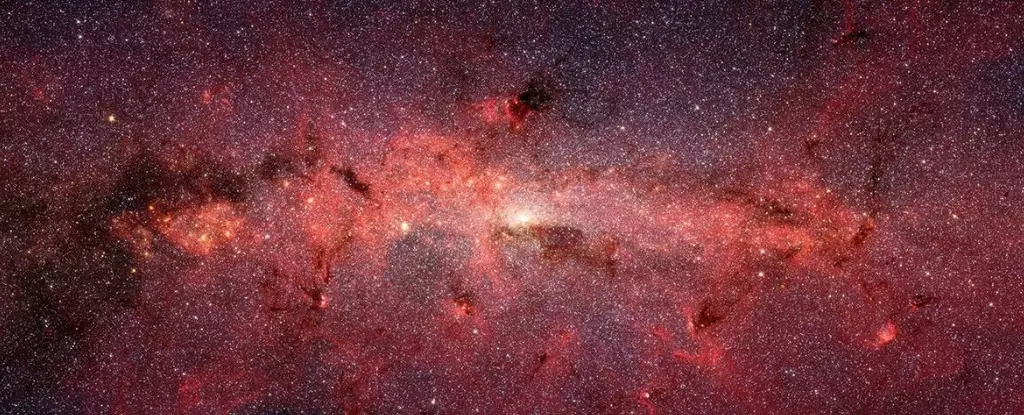The cosmos is a relentless tapestry of mysteries, and at its heart lies the Milky Way, with its enigmatic Central Molecular Zone (CMZ). Spanning nearly 700 light-years, this densely packed region pulsates with an intensity that has confounded astronomers for decades. The ionization of the gas within the CMZ unfolds as a troubling riddle; elements that should remain stable are being stripped down into charged particles at an alarming pace. This alarming trend raises serious questions: what’s happening beneath the surface of our galaxy’s heart, and what role does dark matter play in this cosmic drama?
The ignorance surrounding this phenomenon is frustrating yet fascinating; the answers remain tantalizingly out of reach. Conventional hypotheses point to cosmic rays and stellar light as potential culprits, but empirical evidence suggests these explanations fall short of accounting for the dramatic ionization levels observed. The truth is, while mainstream science has attempted to position cosmic rays as the driving force, their contribution appears grossly inadequate in explaining the extraordinary events happening in the CMZ.
Mysterious Gamma Rays: Echoes of Annihilation
Compounding this perplexity is the spectral chorus of gamma rays resonating at 511 kilo-electronvolts (keV). These bursts, born from the collision and annihilation of electrons and their antiparticles—positrons—engender another question mark in an already complex narrative. At first detected in the 1970s, the source of these enigmatic gamma rays has baffled the scientific community. Various hypotheses have arisen, including supernovae, massive stellar entities, black holes, and neutron stars, yet none have efficiently unpacked the intricacies behind the high-energy emissions.
Is it possible that the key to this cosmic puzzle lies in a shared origin of both phenomena? Could they stem from a hidden mechanism encompassing the forces that bind galaxies?
Dark Matter: The Phantom Force
Dark matter represents one of the most profound conundrums online with the 85% of the universe that remains elusive, its presence felt through gravitation but never seen directly. Speculative discussions venture into the unknown, suggesting that dark matter might comprise particles far lighter than protons, earning them the term “sub-GeV dark matter.” These elusive particles potentially have the power to interact with their antiparticles. If such theories hold any merit, could they be responsible for the extraordinary activity within the CMZ, establishing a chain reaction that results in both ionization and photon emissions?
A bold exploration into this hypothesis suggests that, within the dense confines of the CMZ, these particles may annihilate, producing a torrent of electrons and positrons. These newly formed particles would interact with the hydrogen gas around them, creating a local environment ripe for widespread ionization. Such a scenario beautifully aligns with the observed patterns of energy dispersion and implies a far more intricate interaction of the fundamental forces at play within our galaxy.
Bridging Two Mysteries: A Unified Explanation
Compelling computational models draw a direct line connecting dark matter annihilation to both the ionization levels and the 511 keV emissions. It appears that dark matter could explain the extraordinary phenomena within the CMZ, acting as the hidden puppet master behind the scenes. Such alignment holds profound implications, not only elucidating the strange emissions that have stumped astronomers for generations but also offering a potential gateway into understanding dark matter’s fundamental properties.
Indeed, the beauty lies in the simplicity of the model: dark matter particles, upon colliding with their antiparticles, unleash a cascade of interactions resulting in ionization. This process not only illuminates the CMZ’s enigmatic characteristics but also circles back to the heart of the persistent gamma-ray conundrum. So many truths hinge on understanding these interactions, yet we remain perilously close to the edge of insight without firmly grasping the core dynamics involved.
Looking Ahead: The Search for Answers
As we stand at the precipice of discovery, the future of cosmic exploration beckons. Enhanced observational tools and improved resolution in telescopes will undoubtedly yield deeper insights into the CMZ’s mysteries, paving the way for groundbreaking revelations about dark matter’s nature. If subsequent investigations confirm the intriguing connection between ionization rates and gamma-ray emissions, we may soon witness a profound paradigm shift in the realm of astrophysics.
Indeed, the CMZ could serve as an extraordinary laboratory where the dark matter hypothesis transforms from abstraction to empirical reality. The potential implications—if validated—could redefine our understanding of the universe, illuminating its darkest corners and ushering in an era in which we confront the fundamental questions of existence with unprecedented clarity.
In this ongoing saga of cosmic discovery, the Milky Way does not merely serve as a backdrop; it emerges as a portal into the very fabric of our universe, challenging our perceptions and urging us to delve deeper into the unknown. In the heart of the galaxy lies a mirror reflecting not just the mysteries of our cosmic home but also the latent forces shaping our ever-unfolding quest for knowledge.


Leave a Reply